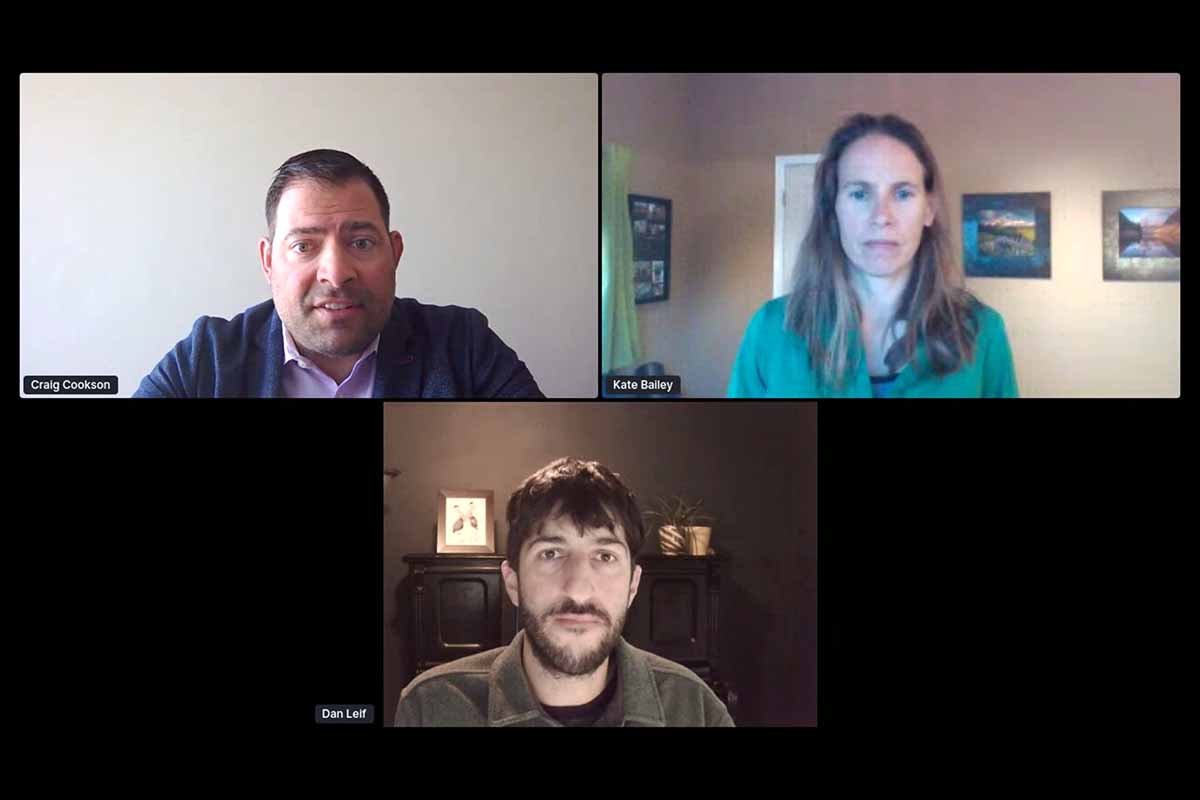
Craig Cookson of the American Chemistry Council and Kate Bailey of Eco-Cycle spoke during a session moderated by Dan Leif of Plastics Recycling Update at the 2021 Plastics Recycling Conference. | Screenshot from the 2021 Plastics Recycling Conference.
The recent Plastics Recycling Conference, held online, featured eight sessions over two days. Here are some of the talking points that caught our team’s attention.
The rise in resin pricing? It’s likely set to end
Record-high recycled polyolefins prices are expected to drop in the latter half of this year, although the prices probably won’t fall as much as virgin prices, according to Joel Morales, executive director of Polyolefins Americas for IHS Markit.
In an April 7 session covering resin markets, Morales explained a few of the drivers behind higher polyolefins pricing: COVID-19 boosted demand for PE and PP, and at the same time plastic production was hampered by both the virus and the early 2021 deep freeze in Texas. Costs to ship resin (and other goods) from Asia to North America have risen sharply, and China’s demand for plastic has grown considerably. Those factors have lifted prime prices, which has helped lift recycled HDPE and PP prices to new heights (recycled natural HDPE pricing was also boosted by brand owner sustainability goals, Morales noted).
But Morales expects virgin and recycled resin prices to come down starting in a couple of months. That’s because plastic production is expected to catch up to demand, and Asia-to-North-America freight markets are expected to normalize a bit. That being said, he doesn’t think recycled resin prices will drop as fast as virgin – for every penny that virgin plastic prices drop, recycled HDPE and PP prices may drop by six-tenths of a penny, he predicted.
“Recycled is being used really because brand owner and downstream awareness is asking for it,” he said.
Overall, IHS Markit forecasts pricing troughs for PE and PP in coming years as a result of new production capacity coming on-line, but those declines aren’t expected to be too deep because COVID-19 has created a new normal of higher demand.
For PET, the pandemic-stimulated demand boost has differed by region, with North America experiencing a 4.5% increase in demand in 2020, said Martin Wiesweg, IHS Markit’s executive director of Polymers EMEA. Production capacity growth will slow over the next couple of years until a large Corpus Christi, Texas plant comes on-line, likely in late 2023, he said. That plant, with a capacity of over 1 million tons of PET per year, will be a “game changer,” helping to drive down virgin PET prices until they reach parity with imported resin.
In terms of RPET, IHS Markit sees an increase in PET bottle collections worldwide in coming years, with Wiesweg noting the high recovery rates enabled by bottle deposit programs and brand owner demand. Overall, virgin plastic demand will slow in the future and RPET demand will grow.
The latest on state-level EPR
Three speakers outlined efforts in Maine, New York and California to implement packaging EPR during an April 7 session. Extended producer responsibility (EPR) policies make packaging producers responsible for the funding and management of the collection and recycling of end-of-life materials.
Maine state Rep. Nicole Grohoski said a bill she’s supporting will help boost recycling rates, reduce costs for municipalities and ratepayers, and drive improvements in packaging design. Her state’s bill will include an eco-modulation concept, through which producers pay lower fees for selling packaging that is easier to recycle, less toxic, includes more PCR and has better instructions to the consumer for recycling.
The Maine bill is still in the final drafting stage, but Grohoski expects it to be introduced very soon.
In New York, Sen. Todd Kaminsky, chair of the Senate’s Environmental Conservation Committee, has made an EPR bill his No. 1 priority this session, he said. The goal is to boost recycling rates and increase the use of recycled materials, while also reducing municipalities’ costs, so they can lower taxes or invest in other needed projects they may not have been able to afford (his town on Long Island has a 100-year-old water tower in need of replacing, for example, he said).
On the West Coast, California has a number of EPR programs in place for various materials, and legislators have introduced packaging EPR bills. Heidi Sanborn, executive director of the National Stewardship Action Council and chair of the California Statewide Commission on Recycling Markets and Curbside Recycling, shared a few lessons California has learned. She warned against handing the keys over to producers without having clear expectations in statute and a well-funded state agency to provide oversight. “Never let the fox watch the chicken coop,” she said. “That is never a good idea. It doesn’t go well.”
She also urged that recycling stakeholders be given a formal voice in the system; otherwise, the producers’ stewardship group will ignore them, Sanborn said.
Another recycling rate decline
In a presentation during the conference’s opening panel on April 7, Nina Butler of Stina Inc. shared some initial data from the annual plastics recycling research her company (which was formerly called More Recycling) performs with support from several industry groups.
Butler said the soon-to-be-released study will show that in 2019, the all-bottle recycling rate for the U.S. was 28.4%. This represents a drop of 0.5 percentage points from the 2018 number, and it continues a trend of falling rates in plastic bottle recycling that has been seen since 2016. The summary report of all the categories of post-consumer plastic recovered for recycling is new; in the past, separate annual recycling reports were performed for different plastic categories.
Butler said that the continued move away from the export market and low virgin pricing both contributed to the drop in 2019 – both of those factors lessened demand for recovered plastic. The research determined 88% of of U.S. post-consumer material plastic recovered for recycling was processed in the U.S. or Canada.
Butler said declining plastics recycling rates might be reversed in future years as the market finds its footing in the wake of China’s National Sword import prohibition. “We’re hopefully going to be shifting away from that trend as we adjust to not having as much material going offshore,” she said.
Case studies in innovation
Recycling technologies were the focus of an April 8 panel featuring leaders of chemical companies Eastman and SABIC and PET reclaimer PetStar.
Matthew Marks, senior sustainability specialist at SABIC, noted that his company has portfolios of both mechanically recycled polymers and chemically recycled plastics. SABIC earlier this month announced a PC/PET compound made with at least 10% mechanically recycled PET, which is recovered from areas where the plastic is at risk of becoming marine pollution. The company has also commercialized recycled plastics made via a pyrolysis process, which converts mixed plastics into an oil that is fed into plastic production equipment. SABIC’s chemically recycled PP is being used in Magnum brand ice cream tubs sold in Europe.
Holli Alexander, Eastman’s strategic initiatives manager for global sustainability, discussed her company’s large-scale push into chemical recycling. By 2030, her Kingsport, Tenn.-based company wants to recycle over 200 million pounds per year of scrap plastic via chemical recycling technologies. Eastman recently broke ground on a $250 million methanolysis plant, which will break down low-grade polyester scrap into chemicals that can be used in new products.
The capacity of the plant, which is now expected to come on-line in 2023, will be around 110,000 metric tons annually. Eastman is working to develop a supply chain for scrap plastic that’s not better suited for mechanical recycling, Alexander said. “We want to expand the pie rather than divide up the pie of recycled materials that are already being collected,” she said.
Jaime Camara, CEO of PetStar, said his Mexico City-based recycling operation demonstrates that mechanical recycling of PET into drink packaging is viable on a large scale. His company is owned by Coca-Cola bottlers, who use the RPET in their bottles, including at up to 100% recycled content. PetStar pulls feedstock from around 1,200 collection points and produces around 120,000 pounds per year.
The company converts B Grade bales into high-quality resin. Technology is part of what enables that achievement – PetStar relies on a front-end sorting system, AMUT wash lines and Polymetrix extrusion and solid-stating equipment. But the reclaimer also relies on standardized processes and qualified personnel, Camara said. “You need to have the right technology, but it’s much more complex than that,” he said. “I’ve seen many failures in recycling with the right technology and many successes with maybe not that good of technology.”
Kudos to Malaysia
Recently, decision-making in Malaysia has grabbed the attention of many in the recycling industry. Customs officials in the Asian nation have rejected around 300 containers of scrap plastics over the past two years, Reuters reported April 6. At the same time, one much-watched container from Los Angeles has been accepted into the country.
During an April 8 session looking at changes to the Basel Convention waste treaty, Adina Renee Adler of the Institute of Scrap Recycling Industries said that over the past couple of years, Malaysian officials have been working hard behind the scenes to understand the specifics of scrap plastic shipping and contamination. This work came as importers and exporters scrambled to make sense of new Basel Convention rules on the regulation of plastic exports, which took effect at the start of this year.
“I do want to give the Malaysian government a great deal of credit,” Adler said. “They started to implement the Basel Convention changes earlier – in 2020 or even 2019. They were trying to control non-compliant material, but it also gave them time to train customs agents. They reached out to us and other organizations to understand specifications. … It’s been a real pleasure, ironically, to watch all that take place, to see them understand what truly is waste and what is a usable end-use manufacturing product.”
Defining the scope of a U.S. pact
The U.S. Plastics Pact is well into its work of helping U.S. companies and organizations fulfill their commitments made through the Ellen MacArthur Foundation’s New Plastics Economy initiative. The pact has a target of 2025 to meet various plastics recycling and waste reduction goals.
As part of that work, pact stakeholders are figuring out which processes count toward targets and how terms such as “materials recovery” are defined.
During an April 7 session, Emily Tipaldo, leader of the U.S. Plastics Pact, described how one hot-button topic in the world of plastics recycling is handled under the pact: Chemical recycling, which is addressed based on the type of technology being employed, in line with guidance laid out by the Ellen MacArthur Foundation.
Broadly speaking, chemical recycling is considered within the scope of materials recovery processes recognized by the pact, alongside mechanical recycling. But the pact looks at the technologies differently based on the end products, Tipaldo explained. If the output is a manufacturing feedstock, such as a monomer that can be used in polymer production, the U.S. Plastics Pact counts it as recycling. But if the process is generating a fuel or oil, it does not count.
“I think one way that we’re looking at it is, again, being mindful of our timeline,” Tipaldo said. “We don’t want to necessarily cut off any one solution, but we need to be realistic about what we’re driving to in the short term.”
The pact will be looking at ways to help further commercialize chemical recycling technologies. That could include supporting the development of bale specifications for chemical recycling.
The debate over whether – and in which cases – chemical recycling should be considered “recycling” is also playing out at the EPA, which recently received a range of comments on how the U.S. should define and measure the national recycling rate.
Packaging debate brings areas of consensus
Speakers in an April 8 session came from two often-opposing sides of the packaging and recycling debate: Craig Cookson of the American Chemistry Council, representing plastics producers, and Kate Bailey of Eco-Cycle, a nonprofit MRF operator in Colorado. Bailey is also a founding member of the Alliance of Mission-Based Recyclers, a group of nonprofit recycling organizations with similar policy goals.
Although Bailey and Cookson represent interests that are frequently at odds, they touched on many areas of agreement. They agreed that well-crafted EPR policies must avoid monopoly control over the recycling system. They discussed the merits and role of life-cycle analyses. They also agreed that the packaging waste discussion needs to focus on a wider array of materials and not only plastics.
Cookson noted that ACC is concerned about any policy that pits materials against each other, for example through punitive fees only on plastic. Bailey agreed it’s not necessarily fair to single out plastics.
“There’s really no such thing as a good disposable,” she said. “Aluminum cans have their own impacts. Glass has impacts. Every material across the board has detrimental impacts. It’s about balancing those concerns.”
That’s not to say the speakers agreed on all topics. The Break Free From Plastic Pollution Act, reintroduced in Congress last month, saw disagreement. Bailey noted that Eco-Cycle and the Alliance of Mission-Based Recyclers are excited for the act and the “huge, systemic policy change” it represents.
ACC, on the other hand, has come out strongly in opposition.
“We’re over 50 minutes in, and finally Kate and I can disagree about something,” Cookson joked as the legislation was discussed near the end of the session.
Moving beyond COVID-19
Like every business sector, the plastics recycling industry is navigating what the end of the pandemic looks like. For some companies, that means helping employees through the vaccination process.
Sonoco Recycling has worked with local medical providers to help employees and their spouses in certain age groups access vaccines. The company has shared the latest vaccination information with employees.
“It’s really mostly about keeping folks educated and accommodating them as they go seek out vaccine,” said Palace Stepps, vice president of recycling for the company, during the April 8 closing session of the conference.
Henrik Dullinger, vice president of business development for reclaimer PreZero, said his company is figuring out how to move back into increased employee business travel. The company has multiple locations, and travel has been a necessity for some company representatives during the pandemic. Recently, Dullinger said he perceives more interest in business travel as more people get vaccinated.
Still, he said, a return to normalcy is not imminent. Mask mandates and COVID protocols will remain part of the company’s practices, he said, and the decision to travel will lie with the employee.
“We will keep it optional for those people, even if they’re vaccinated, to travel via airplane,” Dullinger said. “We don’t want to make it mandatory at this point. Everybody needs to feel more comfortable getting back out there.”
Senior Reporter Colin Staub, Managing Editor Dan Leif and Associate Editor Jared Paben contributed to this report.
A version of this story appeared in Plastics Recycling Update on April 14.
More stories about plastics
- Colorado Summit for Recycling taps trending topics
- Plastic procurement tactics adapt to supply realities
- How AI imaging is helping MRFs and a reclaimer



